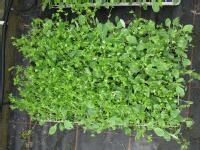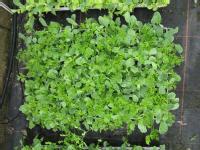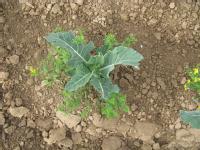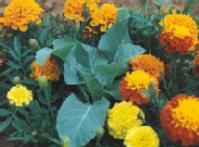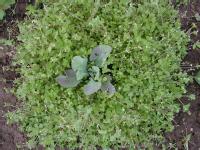Companion Planting
Many studies have shown that the numbers of pest insects found on crop plants are reduced considerably when plant diversity is increased within the crop. Several different hypotheses have been proposed and in 2000, following detailed studies of the behaviour of pest insects of cruciferous plants, Stan Finch and Rosemary Collier put forward a theory to explain this phenomenon. This theory proposes that the colour, size and shape of companion plants, rather than the volatile chemicals they release, determine their effectiveness in reducing insect colonisation.
Much of the evidence to support this theory was provided from insect behaviour studies done at Warwick HRI during collaborations between Stan Finch and three visiting workers/students (Kostal, Kienegger, Billiald). Although this work has been based on cruciferous plants and their pests, the results are relevant to crops from other plant families. Key findings to support this theory are that:
- Searching insects land on green surfaces, but avoid brown surfaces such as the soil.
- Artificial green plants or green paper (releasing no volatile chemicals) are as effective as companion plants as living green plants. The insects do not appear to discriminate between green surfaces on the basis of differences in colour or odour.
- Aromatic companion plants are no more effective than less pungent species and pest insects do not avoid the foliage of aromatic plants.
The theory proposes that the host plant selection process occurs as follows:
a) Plant odours stimulate searching insects to land.
b) The insects land on any green object (but avoid brown objects such as bare soil). Whilst landing, they do not differentiate between the greens, or the odours, of host and non-host plants. Therefore the insects may land on a host plant (appropriate landing) or on a non-host plant (inappropriate landing).
c) The insects that make inappropriate landings remain on the plant for some time and then fly off. They may repeat the process, or they simply leave the area.
d) Once an insect lands on a host plant it then assesses the suitability of the plant using chemical receptors on its feet and mouthparts. This may involve the insects making short flights from leaf to leaf. On plants surrounded by bare soil, most of the insects land back on the same plant (appropriate landing). On plants surrounded by non-host plants, some insects land on the non-host plants (inappropriate landing) and then leave.
Although the colour, size and shape of companion plants, rather than the volatile chemicals they release, appear to determine their effectiveness in reducing insect colonisation, it is likely that volatile chemicals provide the initial stimulus to land in the vicinity of a host plant. In addition, the final decision to accept a host plant for egg laying or as a feeding site is likely to be based on contact chemical stimuli.
References
Kostal, V. & S. Finch (1994). Influence of background on host-plant selection and subsequent oviposition by the cabbage root fly (Delia radicum). Entomologia Experimentalis et Applicata 70: 153-163.
Finch, S. & M. Kienegger (1997). A behavioural study to help clarify how undersowing with clover affects host-plant selection by pest insects of brassica crops. Entomologia Experimentalis et Applicata 84: 165-172.
Finch, S. & Collier, R.H. (2000). Host-plant selection by insects – a theory based on ‘appropriate/inappropriate landings’ by pest insects of cruciferous plants. Entomologia experimentalis et applicata 96, 91-102.
Finch, S., Billiald, H. & Collier, R.H. (2003). Companion planting - do aromatic plants disrupt host-plant finding by the cabbage root fly and the onion fly more effectively than non-aromatic plants? Entomologia Experimentalis et Applicata 109: 183-195.
Morley, K., Finch, S. & Collier, R.H. (2005). Companion planting – behaviour of the cabbage root fly on host plants and non-host plants. Entomologia experimentalis et applicata, 117, 15-25.
Finch, S. & Collier, R.H. (2012). The influence of host and non-host companion plants on the behaviour of pest insects in field crops. Entomologia experimentalis et applicata, 142, 87-96.

